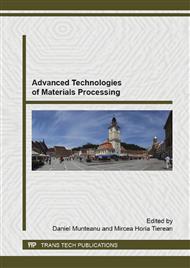p.209
p.217
p.224
p.230
p.236
p.242
p.254
p.261
p.271
Research on the Use of the MIG/MAG-Tandem Procedure in Welding X52MS Plates for the Manufacture of Pipelines
Abstract:
The pipelines used for carrying fluids and gas, made of specially designed steels in keeping with their intended uses, are obtained by welding on generator or by spiral welding, in a wide range of diameters (from 350 to 1800 mm) and pipe wall widths (between 6 and 40 mm). At present, the following welding procedures are used: automatic submerged arc welding (with 1 and 2 wires), combined with the unilateral or bilateral MIG/MAG welding procedure, according to plate thickness and edge working method. Ongoing researches focus on improving the end product [1, 2, 3, 4, 5, 6] by replacing the submerged arc welding procedure with other welding procedures which use less energy and have high deposit rates. This paper presents the results obtained by using tandem MAG welding, with two wires (2 x ø1.2 mm), in welding Y joint X52MS steel plates. The welds were carried out using a QUIROX 315 welding robot, with a 2-wire tandem MIG/MAG welding head, supplied by 2 QUINTO-GLC 603 welding sources, equipment found at Research Centre C12, Advanced Welding Eco-Technologies, owned by ICDD - UTBV. The results of the tests (carried out as per the enforceable regulations) concerning the characterisation of the executed welds proved that it is possible to obtain welds with lower energy use and lower material-relates costs and high productivity and quality.
Info:
Periodical:
Pages:
236-241
Citation:
Online since:
October 2015
Keywords:
Price:
Сopyright:
© 2015 Trans Tech Publications Ltd. All Rights Reserved
Share:
Citation:


